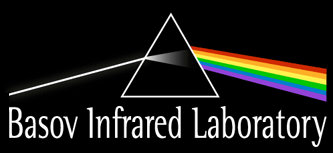Topological Systems
Recently, several compounds have vaulted into the forefront of the condensed matter field after being named prime candidates for the physical realization of a new class of materials, known as topological insulators. A topological insulator has an energy gap in the bulk, however, unlike traditional insulators or semiconductors, topological insulators are topologically inequivalent to the vacuum. A fundamental consequence and principle experimental indicator of the non-trivial topology is one or more robust metallic surface states that are protected both from localization and backscattering by time-reversal symmetry. Beyond the inherent importance of exploring a complex phase of quantum matter, these systems are of great interest for device applications such as quantum computing and photonics.
With the discovery of Dirac and Weyl semimetals, the idea of topology has extended from insulators to semimetals. In topological semimetals, Dirac-like band crossings appear in momentum space and is protected by discrete symmetries. Topological semimetals has attracted great interest since they host quasiparticles that cannot occur in vacuum but do occur in solid-state systems. The nodal-line semimetals extend the point-degeneracies in Dirac semimetals into lines/rings of degeneracies in momentum space. These unusual band structure and topology can be captured by powerful power-law analysis of response functions, e.g. optical spectroscopy.
Semi-Dirac Fermions in a Topological Metal
Shao et al. Physical Review X 14, 041057 (2024) Ref. [368]
Details
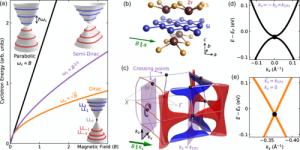 Topological semimetals with massless Dirac and Weyl fermions represent the forefront of quantum materials research. In two dimensions, a peculiar class of fermions that are massless in one direction and massive in the perpendicular direction was predicted 16 years ago. These highly exotic quasiparticles—the semi-Dirac fermions—ignited intense theoretical and experimental interest but remain undetected. Using magneto-optical spectroscopy, we demonstrate the defining feature of semi-Dirac fermions—𝐵2/3 scaling of Landau levels—in a prototypical nodal-line metal ZrSiS. In topological metals, including ZrSiS, nodal lines extend the band degeneracies from isolated points to lines, loops, or even chains in the momentum space. With ab initiocalculations and theoretical modeling, we pinpoint the observed semi-Dirac spectrum to the crossing points of nodal lines in ZrSiS. Crossing nodal lines exhibit a continuum absorption spectrum but with singularities that scale as 𝐵2/3 at the crossing. Our work sheds light on the hidden quasiparticles emerging from the intricate topology of crossing nodal lines and highlights the potential to explore quantum geometry with linear optical responses.
Topological semimetals with massless Dirac and Weyl fermions represent the forefront of quantum materials research. In two dimensions, a peculiar class of fermions that are massless in one direction and massive in the perpendicular direction was predicted 16 years ago. These highly exotic quasiparticles—the semi-Dirac fermions—ignited intense theoretical and experimental interest but remain undetected. Using magneto-optical spectroscopy, we demonstrate the defining feature of semi-Dirac fermions—𝐵2/3 scaling of Landau levels—in a prototypical nodal-line metal ZrSiS. In topological metals, including ZrSiS, nodal lines extend the band degeneracies from isolated points to lines, loops, or even chains in the momentum space. With ab initiocalculations and theoretical modeling, we pinpoint the observed semi-Dirac spectrum to the crossing points of nodal lines in ZrSiS. Crossing nodal lines exhibit a continuum absorption spectrum but with singularities that scale as 𝐵2/3 at the crossing. Our work sheds light on the hidden quasiparticles emerging from the intricate topology of crossing nodal lines and highlights the potential to explore quantum geometry with linear optical responses.
Infrared Plasmons Propagate Through a Hyperbolic Nodal Metal
Shao et al. Science Advances 8, 43 (2022) Ref. [331]
Details
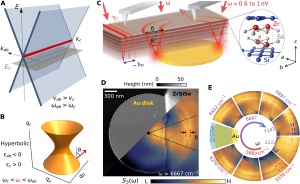 It is expected that layered anisotropic metals will support hyperbolic waveguiding. However, this behavior remains elusive, primarily because interband losses arrest the propagation of infrared modes. Here, we report on the observation of propagating hyperbolic waves in a prototypical layered nodal-line semimetal ZrSiSe. The observed waveguiding originates from polaritonic hybridization between near-infrared light and nodal-line plasmons. Unique nodal electronic structures simultaneously suppress interband loss and boost the plasmonic response, ultimately enabling the propagation of infrared modes through the bulk of the crystal.
It is expected that layered anisotropic metals will support hyperbolic waveguiding. However, this behavior remains elusive, primarily because interband losses arrest the propagation of infrared modes. Here, we report on the observation of propagating hyperbolic waves in a prototypical layered nodal-line semimetal ZrSiSe. The observed waveguiding originates from polaritonic hybridization between near-infrared light and nodal-line plasmons. Unique nodal electronic structures simultaneously suppress interband loss and boost the plasmonic response, ultimately enabling the propagation of infrared modes through the bulk of the crystal.
Electronic correlations in nodal-line semimetals
Shao et al, Nature Physics, 16, 636 (2020) Ref. [282].
Details
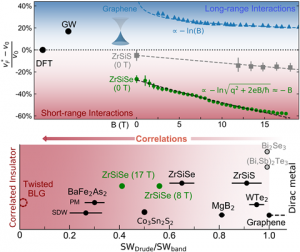 Three-dimensional (3D) Dirac fermions with highly-dispersive linear bands are usually considered weakly correlated, due to relatively large bandwidths (W) compared to Coulomb interactions (U). With the discovery of nodal-line semimetals, the notion of Dirac dispersion has been extended to lines and loops in the momentum space. The anisotropy associated with nodal-line structure gives rise to greatly reduced kinetic energy along the line. Here we report on prominent correlation effects in a nodal-line semimetal compound ZrSiSe through a combination of optical spectroscopy and density-functional-theory calculations. We observed two fundamental spectroscopic hallmarks of electronic correlations: strong reduction (1/3) of the free carrier Drude weight (bottom left) and of the Fermi velocity (top left) compared to predictions of density functional band theory. Interestingly, the suppression of the Fermi velocity is futher tunable with external magnetic field. This work has been highlighted by Silke Paschen and Qimiao Si, Nature Reviews Physics, 3, 9 (2021).
Three-dimensional (3D) Dirac fermions with highly-dispersive linear bands are usually considered weakly correlated, due to relatively large bandwidths (W) compared to Coulomb interactions (U). With the discovery of nodal-line semimetals, the notion of Dirac dispersion has been extended to lines and loops in the momentum space. The anisotropy associated with nodal-line structure gives rise to greatly reduced kinetic energy along the line. Here we report on prominent correlation effects in a nodal-line semimetal compound ZrSiSe through a combination of optical spectroscopy and density-functional-theory calculations. We observed two fundamental spectroscopic hallmarks of electronic correlations: strong reduction (1/3) of the free carrier Drude weight (bottom left) and of the Fermi velocity (top left) compared to predictions of density functional band theory. Interestingly, the suppression of the Fermi velocity is futher tunable with external magnetic field. This work has been highlighted by Silke Paschen and Qimiao Si, Nature Reviews Physics, 3, 9 (2021).
Optical signatures of Dirac nodal lines in NbAs2
Shao et al. Proceedings of the Natural Academy of Sciences 116, 1168 (2019) Ref. [265].
Details
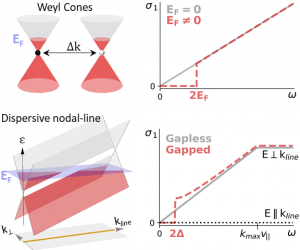 The 3D nodal points in Dirac and/or Weyl semimetals are in the vanguard of quantum materials research. A hallmark of these systems is the linear band dispersion (top left). This latter electronic structure gives rise to unconventional transport and optical phenomena. We demonstrate that solids with dispersive nodal lines in the electronic structure (bottom left) share many common aspects with the response of 3D nodal-points systems. We investigated NbAs2 using a combination of optical and magneto-optical techniques and have identified electromagnetic signature of dispersive nodal lines, see Shao et al, PNAS 116, 1168-1173 (2019). This particular compound has allowed us to inquire the impact of spin-orbit coupling on the universal characteristic of nodal metals. This work has been highlighted in PNAS cover, see also commentary article from Prof. Eugene J. Mele E. J. Mele, PNAS 116, 1084-1086 (2019)
The 3D nodal points in Dirac and/or Weyl semimetals are in the vanguard of quantum materials research. A hallmark of these systems is the linear band dispersion (top left). This latter electronic structure gives rise to unconventional transport and optical phenomena. We demonstrate that solids with dispersive nodal lines in the electronic structure (bottom left) share many common aspects with the response of 3D nodal-points systems. We investigated NbAs2 using a combination of optical and magneto-optical techniques and have identified electromagnetic signature of dispersive nodal lines, see Shao et al, PNAS 116, 1168-1173 (2019). This particular compound has allowed us to inquire the impact of spin-orbit coupling on the universal characteristic of nodal metals. This work has been highlighted in PNAS cover, see also commentary article from Prof. Eugene J. Mele E. J. Mele, PNAS 116, 1084-1086 (2019)
Faraday Rotation Due to Surface States in the Topological Insulator (Bi1–xSbx)2Te3s
Shao et al. Nano Letters 17, 980 (2017) Ref. [237].
Details
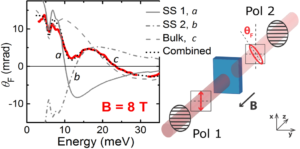 Using magneto-infrared spectroscopy, we have explored the charge dynamics of (Bi,Sb)2Te3 thin films on InP substrates. From the magneto-transmission data we extracted three distinct cyclotron resonance (CR) energies that are all apparent in the broad band Faraday rotation (FR) spectra. This comprehensive FR-CR data set has allowed us to isolate the response of the bulk states from the intrinsic surface states associated with both the top and bottom surfaces of the film. The FR data uncovered that electron- and hole-type Dirac Fermions reside on opposite surfaces of our films, which paves the way for observing many exotic quantum phenomena in topological insulators.
Using magneto-infrared spectroscopy, we have explored the charge dynamics of (Bi,Sb)2Te3 thin films on InP substrates. From the magneto-transmission data we extracted three distinct cyclotron resonance (CR) energies that are all apparent in the broad band Faraday rotation (FR) spectra. This comprehensive FR-CR data set has allowed us to isolate the response of the bulk states from the intrinsic surface states associated with both the top and bottom surfaces of the film. The FR data uncovered that electron- and hole-type Dirac Fermions reside on opposite surfaces of our films, which paves the way for observing many exotic quantum phenomena in topological insulators.
Topological insulators are tunable waveguides for hyperbolic polaritons
Wu et al. Physical Review, 92 205430 (2015). Ref. [217].
Details
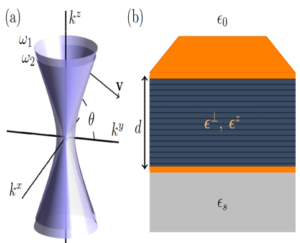 Iron-based superconductors have been found to exhibit an intimate interplay of orbital, spin, and lattice degrees of freedom, dramatically affecting their low-energy electronic properties, including superconductivity. Albeit the precise pairing mechanism remains unidentified, several candidate interactions have been suggested to mediate the superconducting pairing, both in the orbital and in the spin channel. Here, we employ optical spectroscopy (OS), angle-resolved photoemission spectroscopy (ARPES), ab initio band-structure, and Eliashberg calculations to show that nearly optimally doped NaFe0.978Co0.022As exhibits some of the strongest orbitally selective electronic correlations in the family of iron pnictides.
Iron-based superconductors have been found to exhibit an intimate interplay of orbital, spin, and lattice degrees of freedom, dramatically affecting their low-energy electronic properties, including superconductivity. Albeit the precise pairing mechanism remains unidentified, several candidate interactions have been suggested to mediate the superconducting pairing, both in the orbital and in the spin channel. Here, we employ optical spectroscopy (OS), angle-resolved photoemission spectroscopy (ARPES), ab initio band-structure, and Eliashberg calculations to show that nearly optimally doped NaFe0.978Co0.022As exhibits some of the strongest orbitally selective electronic correlations in the family of iron pnictides.
Sum-Rule Constraints on the Surface State Conductance of Topological Insulators
Post et al. Physical Review Letters 115, 116804 (2015). Ref. [212].
Details
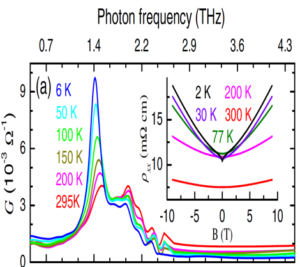 We report the Drude oscillator strength D and the magnitude of the bulk band gap Eg of the epitaxially grown, topological insulator BiSb2Te3. The magnitude of Eg, in conjunction with the model independent f-sum rule, allows us to establish an upper bound for the magnitude of D expected in a typical Dirac-like system composed of linear bands. The experimentally observed D is found to be at or below this theoretical upper bound, demonstrating the effectiveness of alloying in eliminating bulk charge carriers. Moreover, direct comparison of the measured D to magnetoresistance measurements of the same sample supports assignment of the observed low-energy conduction to topological surface states.
We report the Drude oscillator strength D and the magnitude of the bulk band gap Eg of the epitaxially grown, topological insulator BiSb2Te3. The magnitude of Eg, in conjunction with the model independent f-sum rule, allows us to establish an upper bound for the magnitude of D expected in a typical Dirac-like system composed of linear bands. The experimentally observed D is found to be at or below this theoretical upper bound, demonstrating the effectiveness of alloying in eliminating bulk charge carriers. Moreover, direct comparison of the measured D to magnetoresistance measurements of the same sample supports assignment of the observed low-energy conduction to topological surface states.

